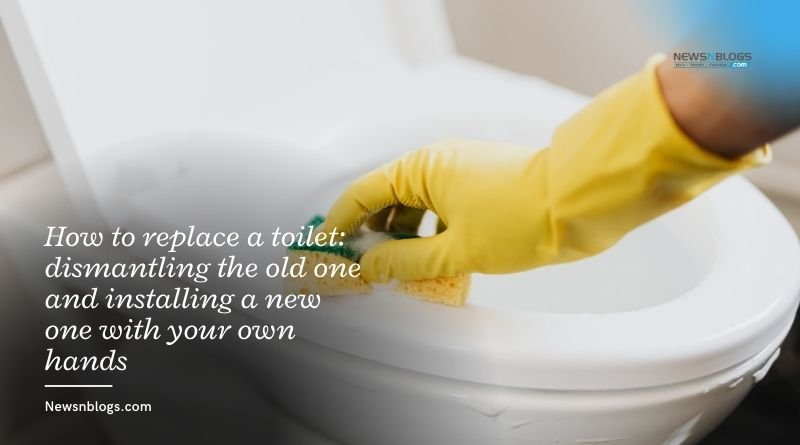Well-installed plumbing equipment can last for years. However, everything has a certain lifespan, and there comes a time when it becomes clear that replacing the toilet is inevitable. For many, this procedure does not cause much trouble: you just need to call one of several dozen companies that provide plumbing services, and the craftsmen will carry out all the work in a matter of hours. However, for a number of reasons, this may not be possible, and then the equipment will have to be changed independently.
What needs to be prepared before work?
First of all, you should buy a new toilet. To do this, you need to understand the design and dimensions of the old one. We measure the room in detail and carry out a simple drawing, on which we indicate the installed toilet bowl and the sewer and water pipes connected to it. Check the angle of the drain. It is, as a rule, 45 °, but it is better to verify this again.
If such work is to be carried out for the first time, and there is very little experience, you can take a photograph of the structure with your phone before going to the store in order to consult with the seller regarding the type of the new device. It will be much easier to choose a new toilet based on the drawing and photo. Pay attention to the dimensions of the device, shape and design features. On sale you can find devices with different depths and bowl shapes, drain slopes and flush designs. Let’s not forget about the design. Among a variety of shades and materials, you should choose the best option for your room. All other things being the same parameters of the device, it is worth giving preference to equipment from well-known companies that produce better products.
In addition to the toilet, you should purchase a small set of items necessary for installation: a cloudy hot water supply hose. Its length is measured according to the old part, the new one is taken with a small margin. Toilet seat mountings. They may come with the equipment, but if not, they need to be purchased. Flexible corrugated pipe or corrugation that connects the toilet to the drain. Cistern. Check the complete set of the tank. If the drain system is not included, it will have to be purchased separately.
You will also need silicone, but not acrylic, sealant, white or transparent, as well as tape and gaskets for water pipes. Of the tools, you cannot do without a hammer drill with a set of drills, it can be replaced with an impact drill with drills, a hammer, a set of screwdrivers and wrenches, a marker, a sharp knife and chisel. Having prepared everything you need, you need to think about how to remove the old toilet. Dismantling the old structure
Before starting work, it is worth preparing buckets and a large amount of rags. We start by disconnecting the cloudy hot water pipe from the device from the drain tank. Drain as much water as possible and unscrew the tank. The toilet is ready to be dismantled. If it is already very many years old, then, most likely, it was installed on a solution. In this case, you need to prepare for the fact that it will not be possible to remove the device intact. Especially if its neck is packed with a rag with paint.
Among the recommendations on how to easily remove the toilet, you can find advice to start work from the drain. This is indeed the case. It is best to hit the throat hard and, splitting it, disconnect the device from the pipe. In addition, the vibration from the impact will somewhat shake the base of the structure, fixed in the solution, which will facilitate further work. Important note: do not hit directly on the drain pipe. If it is cast iron, which is the case in most cases, it is very easy to crack it, which will lead to additional problems
After breaking the neck, we begin to disconnect the device from the floor. If it does not lend itself to the swinging and does not move, we take a hammer and chisel the structure from the base. It is quite possible that as a result of these works, water will flow from the broken device. It needs to be collected with a rag in a bucket. We chop off the fragments of the toilet bowl, remove the remnants of the solution in which it was fixed and, if possible, equalize the floor. We clean the edge of the drain pipe from the fragments of the neck. It is best to do this with old screwdrivers or a chisel. We carry out the operation very carefully so as not to damage the pipe.
Methods for installing new equipment
After dismantling the old toilet, the floor should be repaired, if intended, or simply leveled as much as possible before installing new equipment. There are several ways to install the toilet.
Method # 1 – installation on taffeta
This is the traditional way of installing a toilet. For him you will need taffeta, the so-called hardwood board, carefully rolled. It is placed in the floor under the base of the device so that it is flush with the floor covering or rises slightly above it. The wooden base should be securely fastened to the anchors and the resulting recess should be filled with cement mortar. After the surface is completely dry, you can start installing the device.
The outlet of the equipment is connected to the sewer pipe, then to the socket of the sewer system pipe. All joints are treated with a sealant and sealed with tow. The equipment is installed in the right place and firmly fixed with screws, under the heads of which rubber washers must be laid. The drain tank is mounted and the tightness of the system is checked. The device is now ready for use. It should be noted that this method of dismantling and installing the toilet is perhaps the most laborious compared to others.
Method # 2 – adhesive bonding as practice shows
Plumbing equipment can be installed using epoxy glue. For this, the contacting surfaces must be carefully prepared. They are cleaned and degreased with white spirit, solvent or acetone. They make them rougher, degreased and dried again. After connecting the outlet of the device and the sewer system, an even thin layer of epoxy glue is applied to the supporting surface. The toilet is placed in the prepared place and pressed firmly to the floor. Then it is kept until the glue is completely cured, which will happen no earlier than 12 hours later.
Method # 3 – dowel mounting
The most practical way to change the toilet is the dowel fixing method. In the course of work, the following operations are to be performed:
Fitting the device. We install the toilet on the prepared base and check the coincidence of the height of the neck and the drainpipe, the angle of inclination, etc. If there are inconsistencies, we make the necessary adjustments.
- We mark the structure. We measure the width of the room, find the middle of the axis of the toilet. We install the device on it at a distance of 10-15 cm from the socket of the waste pipe. We insert a marker into the mounting holes and make marks for the holes, circle the base.
- We collect the flush tank. In accordance with the instructions, we assemble the device and then attach it to the toilet. For complete confidence in the quality of the work performed, you can reinstall the device in place, connect it to the sewerage and water supply system and conduct a test run. After making sure that everything is in order, we drain the water and continue to work on replacing the toilet with our own hands.
- Preparing the mounting holes. Using a hammer drill or punch, we make holes in the marked places. We hammer plastic dowels into them.
- We seal the corrugation. We wipe the pipe dry with a rag and apply silicone on the edges of the rubber band, which will be hidden in the drainpipe, with a generous wavy strip. We carry out a similar operation from the opposite end of the corrugation, lubricating the area that is put on the neck of the toilet bowl.
- We connect the device to the sewer. We insert the corrugation to the edge of the elastic into the sewer pipe, and on the other hand, we firmly put it on to release the equipment. On the seat of the toilet, which was previously outlined with a marker, we lay a special rubber gasket or apply a thick layer of silicone.
- We install the equipment. We put the device in the prepared place, press it, and screw it to the floor. The excess silicone squeezed out during installation is removed with a wet finger, passing along the contour of the device.
Installation is over. You can carry out a test run of water. If the work is carried out correctly, the tank is filled to the desired level, and the flow of fluid stops. No overflow occurs. After draining the water, the cycle repeats. You should also check that the equipment does not leak anywhere. If everything is so, then the installation can be considered successfully completed.
Recommendations on how to change the toilet with your own hands are quite simple. Even a novice plumber can do them. You need to carefully study the instructions, prepare everything you need, and do all the installation steps without haste. The result will delight all household members. A properly installed toilet will reliably serve them for many years.







